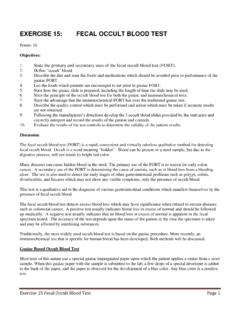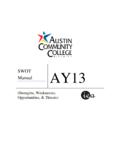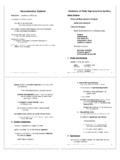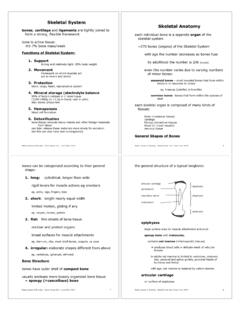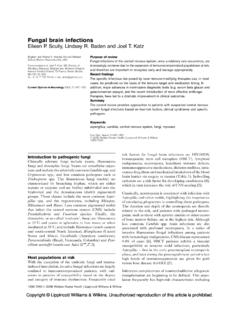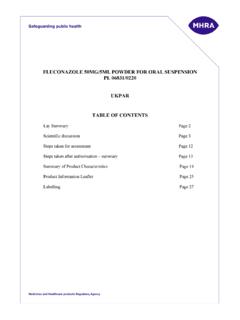Transcription of MLAB 1331: MYCOLOGY LECTURE GUIDE - Austin …
1 1 of 25 mlab 1331 : MYCOLOGY LECTURE GUIDE I. OVERVIEW OF MYCOLOGY A. Importance of MYCOLOGY 1. Introduction MYCOLOGY - the study of fungi Fungi - molds and yeasts Molds - exhibit filamentous type of growth Yeasts - pasty or mucoid form of fungal growth 50,000 + valid species; some have more than one name due to minor variations in size, color, host relationship, or geographic distribution 2. General considerations Fungi stain gram positive, and require oxygen to survive Fungi are eukaryotic, containing a nucleus bound by a membrane, endoplasmic reticulum, and mitochondria.
2 (Bacteria are prokaryotes and do not contain these structures.) Fungi are heterotrophic like animals and most bacteria; they require organic nutrients as a source of energy. (Plants are autotrophic.) Fungi are dependent upon enzymes systems to derive energy from organic substrates - saprophytes - live on dead organic matter - parasites - live on living organisms Fungi are essential in recycling of elements, especially carbon. 3. Role of fungi in the economy a. Industrial uses of fungi (1) Mushrooms (Class Basidiomycetes) Truffles (Class Ascomycetes) (2) Natural food supply for wild animals (3) Yeast as food supplement, supplies vitamins (4) Penicillium - ripens cheese, adds flavor - Roquefort, etc.
3 (5) Fungi used to alter texture, improve flavor of natural and processed foods b. Fermentation (1) Fruit juices (ethyl alcohol) (2) Saccharomyces cerevisiae - brewer's and baker's yeast. (3) Fermentation of industrial alcohol, fats, proteins, acids, etc. 2 of 25 c. Antibiotics First observed by Fleming; noted suppression of bacteria by a contaminating fungus of a culture plate. d. Plant pathology Most plant diseases are caused by fungi e. Medical importance (1) 50-100 species recognized human pathogens (2) Most prefer to be free-living saprophytes; and only accidentally become pathogens (3) To be pathogenic, they must tolerate the temperature of the host site and possess enzymatic system that allows them to parasitize animal tissues.
4 (4) Increased incidence of fungal infections in recent times. 4. Importance of medical MYCOLOGY a. History During the time period between 1941 - 1973, the number of reported deaths in the due to scarlet fever, typhoid, whooping cough, diphtheria, dysentery and malaria decreased from 10,165 cases to 107; but the reported deaths due to mycoses during the same time period, increased from 324 to 530. b. Modern man (1) Increased mobility - Travel to a geographical area where a fungus exists as part of the commensal flora of the local population, or is endemic to the area.
5 (2) The immunocompromised / immunosuppressed (a) AIDS (b) Drugs - tetracycline (acne); birth control pills; indiscriminate use of antibiotics; immunosuppressant drugs used in organ transplant patients, cancer and leukemia patients. (c) Environmental factors - air & water pollution; over processed & "fast" foods; fad diets etc. (3) Ageing population c. Immunology of the Mycoses 3 of 25 (1) Antibody mediated immunity (B-cell humoral) (a) Antibodies are often produced in response to a fungal infection (b) Serological tests for identification of fungal diseases.
6 (2) Cellular mediated immunity (T-cell) (a) T-cell immunity is effective in resistance to fungal infections. II. Definitions - basic terms as they relate to MYCOLOGY A. Basic Structures 1. Hypha (hyphae plural) - fundamental tube-like structural units of fungi. a. Septate - divided by cross walls b. Aseptate - lacking cross walls 2. Mycelium - a mass / mat of hyphae forming the vegative portion of the fungus a. Aerial - growing or existing in the air b. Vegetative - absorbs nutrients c. Fertile - bears conidia or spores for reproduction B.
7 Spores Sporulation & Spores - preferred terms used when there is a merging of nuclear material / genes combine. Fusion of nuclear material. Self-fertile = homothallic. Mating types = heterothallic. Sexual spores - fusion of nuclei 1. Ascospore - spore formed in a sac-like cell known as an ascus, the shape of which aids in identification of the fungus. Often eight (8) spores formed. (sexual). (Ascomycetes) 2. Basidiospore - sexual spore (union of two nuclei) produced on a specialized club-shaped structure, called a basidium.
8 (Basidiomycetes) 3. Zygospore - a thick-walled spore formed during sexual reproduction in the Phycomycetes Asexual spores - most common type 4 of 25 4. Conidia - asexual fungal spores borne externally in various ways from a conidiophore; often referred to a macro- and microconidia. (Ascomycetes & Deuteromycetes). Macroconidia are multicellular Microconidia are unicellular 5. Arthroconidium (Arthrospore) - special type of asexual spore formed by disarticulation of the mycelium. 6. Blastoconidia / Blastospore - asexual spore formed from a budding process along the mycelium or from another blastospore.
9 (class Ascomycetes) 7. Chlamydospore - thick-walled resistant asexual spore formed by direct differentiation of the mycelium (concentration of protoplasm and nutrients) 8. Sporangiospore - an asexual spore contained in a sporangium at the end of a sporangoiphore of the taxonomic class Phycomycetes 9. Thallospore - asexual spore produced on a thallus (hypha). (Deuteromycetes) C. Miscellanous terms 1. Ascus - sac-like structure containing (usually eight) ascospores developed during sexual reproduction in the Ascomycetes.
10 2. Asexual reproduction - spores (reproductive bodies of a fungus) are formed directly from the vegetative mycelium or from specialized hyphae. 3. Chromoblastomycosis - a subcutaneous mycosis often the result of traumatic inoculation of a dematiaceous fungus into the skin; etiologic agents include species of Cladosporium, *Fonsecaea, Exophiala, & Phialophora 4. Coenocytic - a cell or an aseptate hypha containing numerous nuclei. 5. Conidiophore - a specialized branch of hypha on which conidia are developed. 6. Dematiaceous - pigmented, dark in color, usually gray to black.


